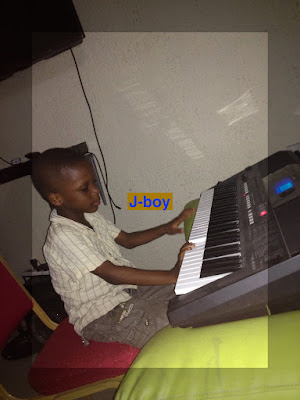Very good to see you here again today!
You already know that with regular practice, you can achieve the impossible. All it takes is a a little commitment and determination to succeed and I assure you that, you will succeed. For me here, I'm always there for you to provide the much needed assistance, reminders, professional advice and to respond to any other challenge you may have.
Lets now discuss this important topic, "Unleash the Genius in Your Kids"
Jahress, what he loved doing
Unleash The Genius in Your Kids
I have spent some time helping some kids as well as adults play. Along the line, I observe that kids improve faster than adults. Something a adult would learn for about 3 weeks, a kid masters it in say 2 weeks or even less.
Remember one important point, and that is, "Kids learn faster than adults". This is so true and if you start now to take advantage of that fact, then your kid could in the next few year be a piano professional. This does not mean, he should stop formal education, no no, the can continue his schooling but in his part time, allow him to play.
Take not of these few points:
1. Dont Allow The Piano Take Precedence over School Work
Ensure that you don't allow your kid use the keyboard as an excuse to avoid school work. What this means is that, when there is home work from school, then make sure the homework is done before playing the keyboard. The reason for this is that playing of the keyboard is addictive. If not checkmated, the kid may become addicted to it and you may not be able to do any other thin.
2. About The Age of the Kid
It is best to allow the kid play once the kid can sit upright, and that would be by the age of say between 3 and 5. This is not too early because the earlier he spend time with the keyboard, the better he is able to master the key arrangement and the better he is able to identify the keys is a short time.
3, No Eating on the Keyboard
Let the kid know that what is done on the keyboard is serious business. Let it be clear to him that the keyboard is not a kind of toy, that he use to know. So when it comes to eating, it should not be on the keyboard. Spilling tea, water or any other drink on the keyboard not only may damage the keyboard but would reduce the child's commitment and interest in learning.
4. Practice Along With the Kid
This depends on your schedule. The point is, if your kid sees that you show some interest in playing from time to time, he would be more determine to do more. Note that playing the piano requires effort on both kids and adults. So seeing you practice your help him put more effort.
5. Give Him a Thumbs up!
This is very important. If you see your kid make progress, then tell him he's doing great. This is a big motivation for him. At certain times, you may need to spend some time beside him listening as he plays. The more you commend him and recognize his effort, the faster he improves. This I have come to realize over the years.
7. Buy Him Kids Piano Books
For me personally, I did not use any book like this. But I know that there are piano books for kids. Just search bookshops around and see if you can get some kind of music/piano books for kid.
About The Guy in The Pix
The little guy in the pix is Jahress Chinedu William. In just one weekend the learnt so much that made me decide to make up this post.
In two days, he learnt.
- Finger positioning
- Posture
- Key arrangement
- Musical Alphabets and more
Final Notes
You cannot say exactly what skill your kid would excel in so give him to exercise his intellect in this important way. Remember, I'm always there to answer to your questions and respond to any challenges you may face. You can just leave a question or comment on the comment box below an I would get back to you. I remain Kindson The Piano Man












